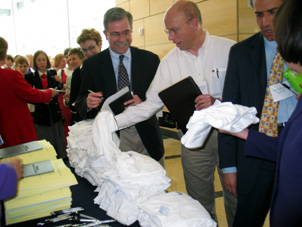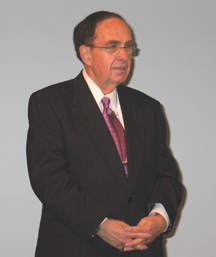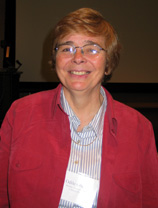 |
Lining up to get agendas and T-shirts are attendees of the June 10-12 International Summit on the Biology and Treatment of the Pediatric Soft Tissue Sarcomas. |
The mission of the COG is to cure and prevent childhood and adolescent cancer through scientific discovery and compassionate care.
UNMC Chancellor Harold M. Maurer, M.D., an expert in rhabdomyosarcoma, the most common form of soft tissue sarcomas, kicked off the three-day summit Thursday in the Durham Research Center.
 |
UNMC Chancellor Harold M. Maurer, M.D., welcomes a group of about 80 conference attendees in the Durham Research Center. |
Attendees include oncologists and researchers from France, Italy, Germany, Spain, the United Kingdom, the Netherlands, and the United States representing the Children’s Oncology Group (North America), the International Society of Paediatric Oncology, the Italian Cooperative Soft Tissue Sarcoma Group, and the German Collaborative Soft Tissue Sarcoma Group.
Odile Oberlin, M.D., of the Instit Gustave Roussy in Villeiuif, France, was one of the attendees. “It’s very important to have these meetings. We have to work together to attack this disease. It’s good to have these relationships with our U.S. colleagues.”
 |
Odile Oberlin, M.D., of the Instit Gustave Roussy in Villeiuif, France, was one of about 80 conference attendees. |
Major accomplishments during the last three decades include: curing up to 90 percent of children with lower-risk rhabdomyosarcoma; identifying important risk groups that permit a more tailored approach the therapy; developing guidelines for surgery and/or radiation therapy based on the size and location of the tumor; understanding biologic and genetic tumor characteristics that help predict how the patient will respond to treatment and identifying several new drugs, and new combinations of drugs, that are effective in treating certain tumors.